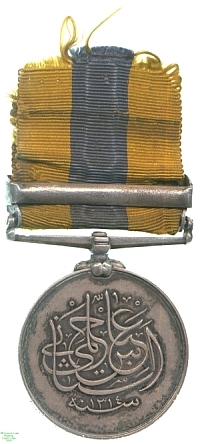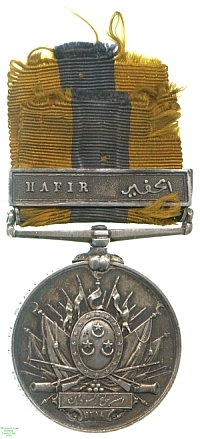
Obverse, the Arabic monogram of Khedive Abbas Hilmi II, with the Arabic date 1314 A. H. in the exergue

Reverse, an oval shield bearing three stars and crescents, before an array of crossed rifles, cannons and standards

Obverse, the Arabic monogram of Khedive Abbas Hilmi II, with the Arabic date 1314 A. H. in the exergue |

Reverse, an oval shield bearing three stars and crescents, before an array of crossed rifles, cannons and standards |
The recovery by Egypt of the Sudan, after its secession under Mahdist rebels in the 1880s, did not by any means mark the end of conflict in that province, which remained restless under an Egyptian control seen merely as a puppet for British imperialism. In fact combat was more or less endemic from 1896 to 1908 and beyond, and in 1897 the Egyptian Army obtained from the Khedive a new medal to be awarded for service in these campaigns. When finally replaced it had been issued with fifteen different bars, and without any bar for the earliest engagements that it covered.
The Battle of Hafir, fought in late September 1896, was the second of a series of engagements with the Mahdist forces of Abdullah ibn Muhammad al-Taashi, who had succeeded the self-proclaimed Mahdi Muhammad Ahmad ibn al-Sayyid as Khalifa in 1895, as their opponents the Anglo-Egyptian Nile Expeditionary Force, under Field Marshal Sir Horatio Kitchener advanced into the rebel province by careful stages. At Hafir, with bombardment support from Navy gunboats, the British forces were able to convincingly rout the Mahdist forces, whose all-out resistance was to be no match for the British firepower in the ensuing campaign.
This medal was awarded to Private T. Birks of the 1st North Staffordshire Regiment. Lester Watson acquired the medal at some point before 1928.